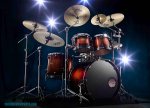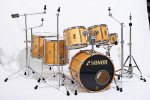Kudos to you on the objective focus and planning. You should be less likely to second guess your decision afterwards as a result of it.
*** WARNING ***
This turned out to be longer than initially intended so veterans may want to exit now... or grab a cup of coffee...
*********************
As far as Tama and Yamaha, I’ve been playing both since the early 80s, and it was actually Tama that first lured me to drums made outside the U.S. Until then, my primary kit was a ‘70 Ludwig Super Classic, I wanted to upgrade to a “monster kit”, and ultimately decided on a ‘82 Tama Superstar. Since then, I’ve played multiple upper-end kits from both manufacturers and had excellent experiences overall. Each has made continual innovations as well as made some missteps in designs and other areas over the years, but again overall positive. Also, like DW, Sonor & others, each company has been cited with over-engineering their gear at various times... repeatedly... but for me, both have delivered some meaningful improvements in the long run.
From this and without trying to sway you to either kit, I believe I can offer some objective input.
In addition to Cost, two other objective metrics to consider would be Quality and Support. Given you’ve honed your selection to these two kits, I presume quality and support were already considered. For most intents and purposes, quality of shell construction, fit & finish, and hardware on both kits are first rate. Additionally, there is nothing so new in technology with either kit that warranty support might be an anticipated need, but selecting an attentive dealer with a strong manufacturer relationship is still important. Happy to discuss this in more detail if you like.
Outside of these metrics, your decision criteria will be more subjectively based on how specific features best meet your Requirements (must haves) and Preferences (nice to haves). To keep things straight, I found it helpful to track my initial kit comparisons with a list... something similar to the following:
— Two columns for Requirements and Preferences respectively.
— Under each, list the features that are most important to you, highest priority to lowest. Don’t worry if you’ve considered every feature, or if they’re in the correct column or correct order. Consider it a living document, it will morph as you go.
— Add two sub-columns under each of the two headings for Tama and Yamaha and assign a number within a range (e.g. 1-5 or 1-10) to rate how well each kit meets that feature.
Try to keep it simple (it’s not a complex decision matrix), and when you ultimately make your choice, don’t be too surprised if the deciding factor is just a gut feeling or a simple preference for a finish. Writing things down usually just helps keep thoughts better organized while researching. (And when you start looking for another kit after this one

, it will be easier to do in your head.)
Based on your comments so far, some specific features that seem to be important or might be relevant are:
— Volume
To my hearing, the Yamaha is/can be notably louder and more aggressive with more cut and projection than the Tama. The phenolic ply and BD weights do contribute to this IMO. If competing un-miked with loud guitarists is a high priority, this could be an important consideration. The following videos of each are representative of what I‘ve heard:
— Tom Mounts
This is one of those topics that seems to be continually debated. Some attest Yamaha’s design is unequivocally the best, while others prefer specific versions (pre-YESS, YESS I, II, IIm or III), while others prefer Tama’s Star-Cast or another brand’s system. For me it boils down to:
1) If you frequently mount & unmount your toms (e.g. for gigging), do you prefer to do so by putting them on/taking them off vertically or horizontally? If you position your drums closely, the vertical L-rod style used by Tama and others can be advantageous. I like a tight config and position my snare & floor high (for some people), but regularly use both styles without issue.
2) Will you frequently tighten & loosen omni-ball wing nuts to setup & collapse your tom arms? If so, I’ve found omni-ball arm designs that use a 1-piece clamp to secure the ball (e.g. Sonor, Yamaha) are more likely to wear faster and lose grip with frequent adjustment. Alternatively, designs that use a 2-piece clamp (e.g. DW, Ludwig, Tama) are less likely to wear with long term use. Not always, but generally. For me, I never collapse tom arms and seldom readjust them. When I need to switch between a 1-up, 2-up or 3-up config that requires different positioning, I either have multiple arms for each setup or use Gibraltar clamshell-style arms instead. Thus, this isn’t an issue for me.
— Quick-Lock vs Wing-Nut Brackets
Tama added their Quick-Lock brackets to the Starclassic line several years ago. A simple push of a switch quickly locks or unlocks tom arms and floor tom legs, and a memory lock and rubber insulator (that may add a very subtle amount of sustain) are integrated. Floor toms can sway a bit if you bump into them, but otherwise both toms and floor toms remain in place while playing. For me, the Quick-Locks are a nice feature, but, the extra 1/4- to 1/2-turn for wing nuts wouldn’t deter me from buying the Yamaha either. YMMV.
— BD Mount vs No-Mount (virgin)
Another often debated subject. Some will say an integrated mount doesn’t reduce sustain and provides for a simpler, quicker setup and more flexibility in positioning. Others will say a virgin kick provides more sustain and offers even more flexibility with no more complexity or time to setup. For me, both can be true and the latter are primarily only factors for gigging...
1) Effect on sustain depends on drum construction and desired sound.
Given the excellent sustain and projection with the Yamaha, I’d call sustain a non-issue here and possibly even a slight edge to a no-mount Tama. If you decide to go Tama with a mount, note that the holder base does not use a hole in the BD... it’s only bolted to it.
2) Positioning flexibility depends on number of mounted toms and desired placement.
This will be for you and only you to determine.
3) Simplicity depends on #2), if multi-holders or multi-clamps are used with stands, and if lightweight stands are preferred.
4) Time to setup depends on #3), minimal collapsing/disassembling and use of memory locks where needed.
A BD without a mount can certainly have a cleaner look, but if you do decide to get either kit with a mount, it would allow you to switch between both mounting options. And you can make a simple homemade plug (more versatile than a blanking plate) to prevent debris from falling in it.
Like others, I don’t believe you can go wrong with either kit. The lower cost difference in Germany just makes it a little tougher/more personal decision.
BTW, if you’d also like to discuss outboard hardware (cymbal & snare stands), it may be best to start a separate thread for it. There’s a lot of people here with good experience and a separate thread will be more noticeable to them.
Hope this helps.



